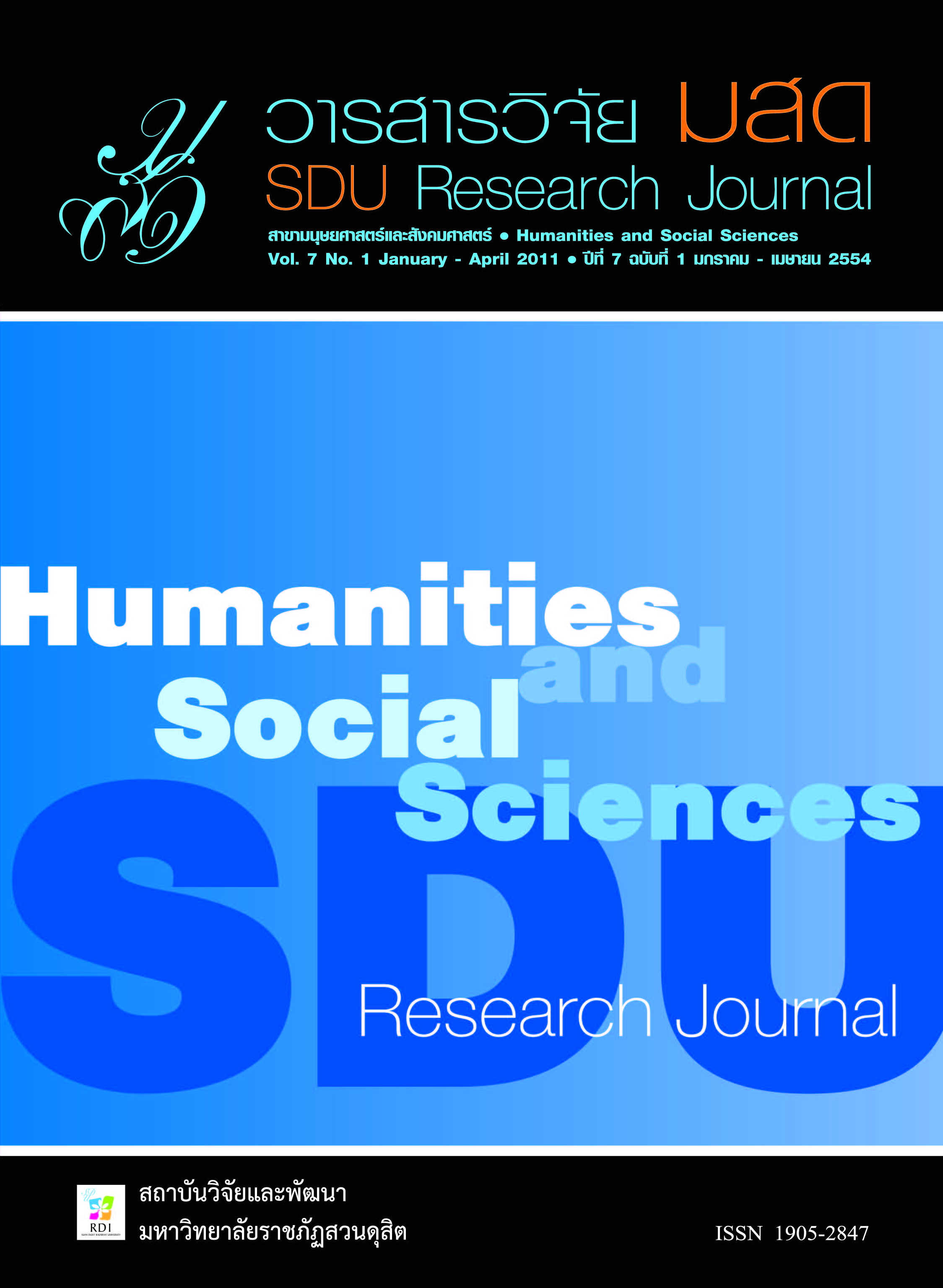รูปแบบพัฒนานักศึกษาตามอัตลักษณ์มหาวิทยาลัยราชภัฏสวนดุสิต
Abstract
บทคัดย่อ
การวิจัยนี้ เป็นการวิจัยแบบผสมผสานระหว่างการวิจัยเชิงคุณภาพและการวิจัยเชิงปริมาณ โดยมีวัตถุประสงค์เพื่อ 1) ศึกษาคุณลักษณะที่พึงประสงค์ของนักศึกษาตามอัตลักษณ์มหาวิทยาลัยราชภัฏสวนดุสิต 2) ศึกษาระดับคุณลักษณะของนักศึกษาตามอัตลักษณ์มหาวิทยาลัยราชภัฏสวนดุสิต 3) สร้างรูปแบบการพัฒนานักศึกษาตามอัตลักษณ์ของมหาวิทยาลัยราชภัฏสวนดุสิต การวิจัยแบ่งการดำเนินการเป็น 3 ขั้นตอน ได้แก่ ขั้นตอนที่ 1 แบ่งการดำเนินการเป็น 2 ส่วน ส่วนที่ 1 การศึกษาคุณลักษณะที่พึงประสงค์ของนักศึกษาด้วยการสัมภาษณ์เชิงลึก ( In-Depth Interview ) ผู้ให้ข้อมูลสำคัญได้แก่ผู้เชี่ยวชาญและผู้บริหารมหาวิทยาลัยฯจำนวน 8 คนนำข้อมูลที่ได้มาวิเคราะห์คุณลักษณะของนักศึกษาตามอัตลักษณ์มหาวิทยาลัยฯ ส่วนที่ 2 การศึกษาระดับคุณลักษณะของนักศึกษาตามอัตลักษณ์มหาวิทยาลัยราชภัฏสวนดุสิต ประชากรที่ใช้ในการวิจัยในครั้งนี้ จำนวน 2,417 คน กำหนดกลุ่มตัวอย่าง ทำการเก็บข้อมูลจากกลุ่มตัวอย่างที่เป็นอาจารย์โดยการเลือกแบบเจาะจง จากอาจารย์ที่เป็นกรรมการหลักสูตร จำนวน 41 คนและกำหนดกลุ่มตัวอย่างที่เป็นนักศึกษาระดับปริญญาตรีหลักสูตร 4 ปี ชั้นปีที่ 3 และชั้นปีที่ 4 ในหลักสูตรที่กำหนดเป็นอัตลักษณ์ 10 หลักสูตร โดยใช้ตารางสำเร็จของ เครซี่และมอร์แกน (R.V.Krejcie and Morgan,1970. pp. 607-610) ได้กลุ่มตัวอย่าง จำนวน 341 คน รวมกลุ่มตัวอย่างทั้งสิ้น 382 คน ขั้นตอนที่ 2 ร่างรูปแบบการพัฒนาคุณลักษณะนักศึกษาตามอัตลักษณ์มหาวิทยาลัยราชภัฏสวนดุสิต โดยวิเคราะห์ข้อมูลจากวรรณกรรมที่เกี่ยวข้อง จากการสัมภาษณ์และข้อมูลจากระดับคุณลักษณะของนักศึกษาที่ศึกษาได้แล้วนำไปให้ผู้เชี่ยวชาญและอาจารย์ที่ปรึกษาตรวจสอบให้ความเห็น ขั้นตอนที่ 3 การประเมินความเหมาะสมของรูปแบบและแนวทางการพัฒนาคุณลักษณะนักศึกษาตามอัตลักษณ์มหาวิทยาลัยราชภัฏสวนดุสิต ด้วยวิธีการสัมมนากลุ่ม(Focus Group)โดยเชิญผู้ทรงคุณวุฒิจำนวน 20 คน ผลการวิจัยพบว่า
1) การศึกษาคุณลักษณะบัณฑิตที่พึงประสงค์ตามกรอบมาตรฐานคุณวุฒิระดับอุดมศึกษาของประเทศไทย( Thai Qualifications Framework for Higher Education; TQF: HEd) ซึ่งประกอบด้วยคุณลักษณะ 6 ด้าน ได้แก่ ด้านบุคลิกภาพ ด้านคุณธรรมจริยธรรม ด้านความรู้ ด้านทักษะทางปัญญา ด้านทักษะความสัมพันธ์ระหว่างบุคคลและความรับผิดชอบ ด้านทักษะการวิเคราะห์เชิงตัวเลข การสื่อสารและการใช้เทคโนโลยีสารสนเทศ พบว่าคุณลักษณะของนักศึกษาตามอัตลักษณ์มหาวิทยาลัยราชภัฏสวนดุสิต ประกอบด้วย
1.1 คุณลักษณะทั่วไปมีคุณลักษณะดังนี้ บุคลิกดี( Good Personality ) มีมนุษยสัมพันธ์ ( Good Human Relationship ) คิดเป็น( Wisely Thinking ) เด่นคุณธรรม ( Outstanding Morality ) นำความรู้( Leading Knowledge ) ดำรงอยู่คู่สังคม (Living in Society)
1.2 คุณลักษณะเฉพาะของนักศึกษา ควรมีคุณลักษณะดังนี้ มืออาชีพ ( Professional) บุคลิกเด่น (Outstanding Personality) เน้นจรรยาบรรณ (Ethical Emphasis) สร้างสรรค์สังคม (Social Change Agent)
2) จากการศึกษาระดับคุณลักษณะของนักศึกษามหาวิทยาลัยราชภัฏสวนดุสิตตามความคิดเห็นของอาจารย์ ในภาพรวมอยู่ในระดับมาก เมื่อพิจารณาเป็นรายด้านพบว่า นักศึกษามีคุณลักษณะในระดับมากทุกด้าน คือ คุณลักษณะด้านคุณธรรมจริยธรรม รองลงมาได้แก่ ด้านทักษะความสัมพันธ์ระหว่างบุคคลและความรับผิดชอบ ด้านทักษะทางปัญญา ด้านบุคลิกภาพ ด้านทักษะการวิเคราะห์เชิงตัวเลข การสื่อสารและการใช้เทคโนโลยีสารสนเทศ และ ด้านความรู้ ตามลำดับ ส่วนระดับคุณลักษณะนักศึกษาตามความคิดเห็นของนักศึกษาในภาพรวมอยู่ในระดับมาก เมื่อพิจารณาเป็นรายด้านพบว่า นักศึกษามีคุณลักษณะในระดับมากทุกด้านคือ คุณลักษณะด้านบุคลิกภาพ รองลงมาได้แก่ ด้านคุณธรรมจริยธรรม ด้านทักษะความสัมพันธ์ระหว่างบุคคลและความรับผิดชอบ ด้านทักษะการวิเคราะห์เชิงตัวเลข การสื่อสารและการใช้เทคโนโลยีสารสนเทศ ด้านความรู้และด้านทักษะทางปัญญา ตามลำดับ
3) จากการวิเคราะห์ข้อมูลการสัมภาษณ์ การศึกษาระดับคุณลักษณะของนักศึกษาและการสัมมนากลุ่มเพื่อประเมินความเหมาะสม สรุปเป็นรูปแบบการพัฒนานักศึกษาตามอัตลักษณ์มหาวิทยาลัยราชภัฏสวนดุสิต ประกอบด้วย 4 ส่วน ได้แก่ ส่วนที่ 1 ส่วนนำ เป็นการอธิบายความเป็นมาของการพัฒนารูปแบบ วัตถุประสงค์ของรูปแบบ แนวคิดทฤษฎีพื้นฐานที่ใช้ในการพัฒนารูปแบบ ส่วนที่ 2 ปัจจัยและแนวทางการพัฒนาคุณลักษณะนักศึกษาตามอัตลักษณ์มหาวิทยาลัย ราชภัฏสวนดุสิต ส่วนที่ 3 เกณฑ์และวิธีการพัฒนาคุณลักษณะนักศึกษาตามอัตลักษณ์มหาวิทยาลัยราชภัฏสวนดุสิต และส่วนที่ 4 เงื่อนไขความสำเร็จในการนำรูปแบบไปใช้
Abstract
This qualitative-quantitative research aims to; 1) study the admired attributes of students according to Suan Dusit Rajabhat University identity, 2) study the attributes level of students according to Suan Dusit Rajabhat University identity and 3) create student development model according to Suan Dusit Rajabhat University identity. The research procedure was divided into 3 steps. Step 1 was also divided into 2 parts; part 1 was to study the admired attributes of students by in-depth interview. The respondents were 8 experts and university administrators. The data obtained was analyzed to find out student attributes according to Suan Dusit Rajabhat University identity and part 2 was the study of student attributes level according to Suan Dusit Rajabhat University identity. Population used were 2,417 people. The samples used were 382 samples that consisted of 41 curriculum administrators who were selected by purposive sampling and 341 third and fourth year students, who studied in 4 year program of 10 identity curriculums, selected by R.V.Krejcie and Morgan Random Table. Steps 2 was to make a draft of a model for developing student attributes according to Suan Dusit Rajabhat University identity by analyzing the data from literature review, interview and the data from the analyzed student attributes level and then the made draft was examined by the experts and the advisors. Step 3 was to evaluate the appropriateness of the developed model and the approaches for developing students according to Suan Duist Rajabhat University identity by inviting 20 experts involved for focus group discussion. The findings were as follows;
1. The admired attributes of students according to Thai Qualifications Framework for Higher Education that consisted of 6 attributes; personality, morality, knowledge, cognitive skills, inter-personal skills and responsibility, numeric analysis skills, communication and the use of information technology, it was found that student attributes according to Suan Dusit Rajabhat University identity were;
1.1 General attributes were good personality, good human relationship, wisely thinking, outstanding morality, leading knowledge and living in society.
1.2 Specific attributes were professional, outstanding personality, ethical emphasis and social change agent.
2. With regard to the study of student attribute level of Suan Dusit Rajabhat University according to the lecturers’ opinions, on the whole was at a great level. When considering in each aspect it revealed that every aspect of student attributes was at a great level. They were morality, interpersonal skills and responsibility, cognitive skills, personality, number analysis skills, communication and information technology skills respectively. For the student attribute level regarding to students’ opinions on the whole was at a great level. When considering in each aspect it also showed at every aspect of student attributes was at a great level. They were personality, morality, interpersonal skills and responsibility, number analysis skills and communication and information technology skills, knowledge and cognitive skills respectively.
3. From data analysis which ontained from interview, study of student attribute level and focus group discussion, it concluded that the student development model according to Suan Dusit Rajabhat University consisted of 4 parts. Part 1 was the introduction that was the explanation about the backgrounds, objectives, concepts and the theories of model development. Part 2 was about the factors and the approaches for developing student attribute according to Suan Dusit Rajabhat University identity. Part 3 the general attributes of students and the specific attributes in 10 curriculums according to the University identity. Part 3 was about the criteria and methods for developing student attribute according to Suan Dusit Rajabhat University identity. . Part 4 was about the successful conditions for model application.







